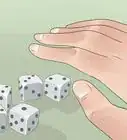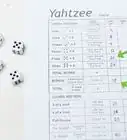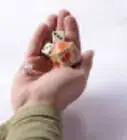This article was co-authored by wikiHow staff writer, Hunter Rising. Hunter Rising is a wikiHow Staff Writer based in Los Angeles. He has more than three years of experience writing for and working with wikiHow. Hunter holds a BFA in Entertainment Design from the University of Wisconsin - Stout and a Minor in English Writing.
There are 7 references cited in this article, which can be found at the bottom of the page.
This article has been viewed 547,329 times.
Learn more...
If you're looking for an easy and fun dice game to play with your friends, Liar's Dice is the perfect thing to try. Liar's Dice has a balance between luck and strategy since you can bluff and deceive your friends about what you rolled. The most common variation uses 5 dice for every player, but you can play a 2-player "common hand" version using just one set of dice. Keep reading to learn all the rules you need to play either variation so you can have an amazing game night.
Things You Should Know
- Have each player secretly roll 5 dice without showing anyone. The first player bids on how many dice they think have a certain face between all players.
- Raise the bid by saying a higher face value or higher number of dice to keep the round going. Make a believable bid based on the dice you have.
- Challenge a player if you think their bid is wrong. All players reveal their dice. If a player bid more than the dice showing, they lose 1 die from their supply.
- Win the game if you’re the last person with dice.
Steps
Single Hand (Multiple Players)
-
1Give each player 5 dice and a dice cup. Liar’s Dice works best with 3 or more players, and you’re only limited by how many dice you have. Make sure each player gets an opaque cup as well so players can shake up their dice without anyone seeing.[1]
- If you don’t have any opaque cups, you can just cover the dice with your hand as soon as you roll them.
- You can buy a Liar’s Dice set that has all the supplies you need to start playing.
-
2Roll 1 die to determine the starting player. Each player takes one of their dice and rolls it. Whoever has the highest roll gets to go first. If there’s a tie for highest roll, then have the tied players roll again.[2]
- After the first person, players take turns going clockwise around the table.
Advertisement -
3Have everyone secretly roll their dice at the same time. Put your dice in your cup and shake them up. Flip the cup face-down on the table to keep your dice hidden. You can peek at your own dice, but be careful so no one else sees what you have.[3]
- If anyone sees another player’s dice, have everyone roll again to start the round over.
-
4Let the first player bid how many total dice of one value were rolled. After they look at their dice, the first player makes a guess at how many dice are showing a certain face value between all of the players. Base the guess on what dice are showing under your cup, but don’t be afraid to bluff and say more than you have.[4]
- Example: If the first player bids “four 3s,” they believe that between all the players, there are at least 4 dice showing a 3.
- Bluffing lets you make a bid even if you don’t have the dice. For example, if you don’t have any 5s, you can still bid “two 5s” if you think other players have the dice under their cups.
-
5Raise the bid if you think there are more dice. The person to the left of the first player takes the next turn and play continues clockwise. If you want to keep the round going and raise the bid, it has to be a higher quantity of dice, a higher face value, or a higher quantity and face value. You can bluff about how many dice you think there are, or base your bid off of what you have under your cup.[5]
- Example: If the first bid is “two 3s,” the next player could bid “three 3s,” “two 4s,” or “three 5s.” “Two 2s” would not be allowed since it’s a lower quantity and face value.
- Some variations consider “1s” to be wild, meaning they can be any value. However, if “1s” are bid by the first player, then they count as their face value for the rest of the round.
- Even if you don’t have any dice under your cup that match your bid, there’s still a good probability that other players have them.
- Be conservative with your bids so you don’t get caught bluffing. Bidding something like “ten 6s” would take a lot of luck, but a bid of “three 6s” sounds more believable.
-
6Challenge the last bid if you think it’s wrong. Instead of raising the bid, you can challenge it to call another player’s bluff and end the round. Say “Liar!” or “Challenge!” when it’s your turn to let the previous player know you don’t believe their bid.[6]
-
7Reveal all the dice when a player challenges. Have everyone lift up their cups to reveal all of the dice. If there are fewer dice showing than the bid, whoever made the bet loses the round. If the number of dice is equal to or more than the bid, the player who made the challenge was wrong and loses the round.[7]
- Example: Raul bets “seven 6s.” Nya doesn’t believe him and challenges. There are nine 6s after revealing the dice, so Raul wins and Nya loses.
- Example: Ali bet “six 3s.” Camila thinks he’s lying and challenges. There are only four 3s showing, so Camila wins and Ali loses.
-
8Lose a die if you lost the round. Take one of the dice out of your cup and set it aside. That die is out for the rest of the game, so you’ll roll fewer dice during the next round.[8]
- If you lose your last die, then you’re knocked out of the game.
- If the person made their bid exactly, you can play with the “spot on” rule and have all players lose a die except for the bidder.
-
9Start the next round with the person who lost the previous round. Everyone takes their remaining dice and rolls them again. The person who lost the last round makes the initial bid for the new round.[9]
-
10Play rounds until there’s only one player with dice left. At the end of each round, at least one player loses a die from their cup. If you ever knock out all the other players, you win the game![10]
- If you get to the point where there are 2 players left that each with only 1 die, bet on the sum of the 2 dice instead, such as “7” or “11.”
Common Hand (2 Players)
-
1Give each player 10 poker chips. Set the poker chips in a stack next to each player. If you want to play a shorter game, use fewer poker chips.
-
2Have each player roll 5 dice to determine the first player. Share the same pool of 5 dice. Whoever has the largest total between all of the dice gets to take the first turn of the game.
-
3Roll the 5 dice with a dice cup to keep them hidden. The first player takes all 5 of the dice and shakes them up in the cup. You can peek at the dice you rolled, but keep them hidden from the other player.
- If you don’t have a dice cup, cover the dice with your hand or roll them in a dice tray in your lap.
-
4Announce or bluff about the dice combo you rolled. Common Hand Liar’s Dice uses dice poker hands when you make your bid. You can tell the truth about what you rolled, or bluff to say you rolled a higher-valued combo. The combos from highest to lowest value are:
- 5 of a kind (Example: 5, 5, 5, 5, 5)
- 4 of a kind (Example: 3, 3, 3, 3, 1)
- Full house (Example: 4, 4, 4, 2, 2) [3 of a kind and a pair]
- High straight (2, 3, 4, 5, 6)
- Low straight (1, 2, 3, 4, 5)
- 3 of a kind (Example: 2, 2, 2, 4, 1)
- 2 pair (Example: 2, 2, 1, 1, 4)
- 1 pair (Example: 3, 3, 5, 4, 1)
- Highest single die
-
5Give the other player a chance to challenge your roll. If the other player thinks you’re lying, they can say, “liar,” or “challenge” to end the round. If they challenge your roll, reveal the dice. If you got caught in a bluff, put one of your poker chips in the center of the table.
- If you told the truth and your opponent was wrong, they put a poker chip in the middle of the table instead.
- Regardless of who won the challenge, a new round starts with a new dice roll.
-
6Pass the dice to your opponent if they think you’re telling the truth. If the other player thinks you’re telling the truth, they pass their opportunity to challenge you. It’s okay for them to see what you rolled now since they can’t challenge you.
- Your opponent will immediately know if you bluffed about your hand, so be cautious bluffing on your next turn since they may catch on.
-
7Roll passed dice and announce a higher poker hand. If your opponent thought you were telling the truth, the round continues and they take their turn to roll the dice. They’ll secretly roll any dice that they don’t want to save and tell you how many dice they’re rolling. Your opponent says the poker hand they rolled, but it has to be a higher value than the one you announced on your turn.
- Example: If you called a low straight on your turn, your opponent has to announce a high straight or higher.
- The player cannot lie about how many dice are being rolled. If they roll 2 dice, they cannot say they are rolling 3.
-
8Continue the round until someone challenges. One player rolls the dice and announces a poker hand at a time. Remember that you have to announce a higher poker hand than the last roll to keep the round going. Once a player challenges a hand, whoever last rolled the dice reveals them.
-
9Play until one person runs out of poker chips. If you lose your last poker chip from your opponent calling your bluff or incorrectly challenging their roll, then you lose the game. Whoever has any poker chips leftover wins.
Community Q&A
-
QuestionHow do I play when there are five aces?
 Community AnswerYou can ask for a reroll but it would be better to make small bets until the other player makes a bet and you can call them a liar.
Community AnswerYou can ask for a reroll but it would be better to make small bets until the other player makes a bet and you can call them a liar. -
QuestionIf the loser of the challenge goes first, what if that was the last die and the player is out of the game?
 Community AnswerThen the player to the losing player's right starts the next round.
Community AnswerThen the player to the losing player's right starts the next round. -
QuestionCan a player who makes the first call change the call when playing Liar's Dice?
 Community AnswerYes. As the play keeps going around the circle, players make a new call that supersedes their previous call. Only the most recent call of any player really matters.
Community AnswerYes. As the play keeps going around the circle, players make a new call that supersedes their previous call. Only the most recent call of any player really matters.
Things You’ll Need
Single Hand (Multiple Players)
- 5 dice per player
- Dice cup for each player
- Liar’s Dice game (optional)
Common Hand (2 Players)
References
- ↑ https://magisterrex.files.wordpress.com/2014/07/liarsdice1987.pdf
- ↑ https://www.horizonhobby.com/on/demandware.static/Sites-horizon-us-Site/Sites-horizon-master/default/Manuals/FNP2032_LiarsDiceRule.pdf
- ↑ https://endlessgames.com/wp-content/uploads/instructions/Liars_Dice_Instructions.pdf
- ↑ https://www.ucd.ie/mathstat/t4media/8.%20Liar's%20dice%20and%20binomial%20random%20variables.pdf
- ↑ https://web.stanford.edu/class/cs109l/unrestricted/assignments/assn1a/liarsdice.pdf
- ↑ https://nietaki.com/2015/12/12/liars-dice-best-rules-variation/
- ↑ https://youtu.be/Xzr_Os_qkGo?t=71
- ↑ https://www.horizonhobby.com/on/demandware.static/Sites-horizon-us-Site/Sites-horizon-master/default/Manuals/FNP2032_LiarsDiceRule.pdf
- ↑ https://www.horizonhobby.com/on/demandware.static/Sites-horizon-us-Site/Sites-horizon-master/default/Manuals/FNP2032_LiarsDiceRule.pdf
About This Article
Liar’s Dice is a fun dice game for 2 or more players where everyone tries to trick their opponents and be the last one standing. To play, you’ll need 5 dice for each player. Each player will also need a cup so they can keep their dice hidden. To start the game, each player rolls all of their dice simultaneously on the table. All of the players look at what they rolled, keeping their dice hidden from the other players with their cup. Then, the first player states a bid consisting of one of the die faces, (1, 2, 3, 4, 5, or 6), and a quantity. The quantity is equal to how many of that face they think everyone at the table rolled. For example, they might bid seven 4’s. After the first player bids, the player to their left bids next. They can bid a higher quantity of the same face, or bid the same quantity of a higher face. Play continues like this clockwise around the table until a player challenges the previous player’s bid. When a challenge occurs, everyone reveals their dice. If the bid is correct, or if there are more faces than the bidder stated, the bidder wins the challenge and the challenger loses one die. If there are fewer faces than the bidder stated, the bidder loses one die. Then, a new round begins with the loser of the previous round making the first bet. Continue playing until only one player is left with dice and wins the game. If there are ever 2 players with one die each, players bid the sum of the 2 die instead of the quantity of faces. For more tips, including how to play liar’s dice with only 2 players, read on!








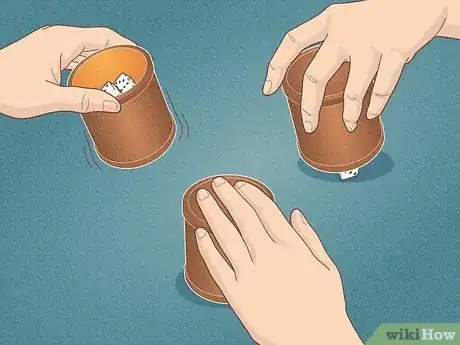









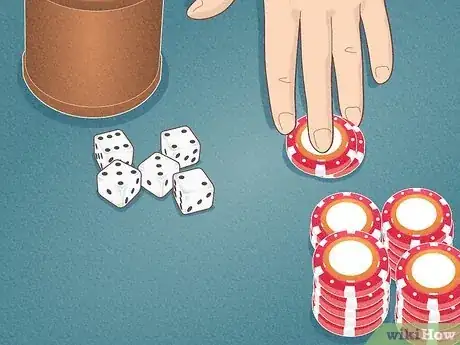
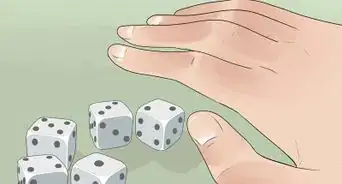

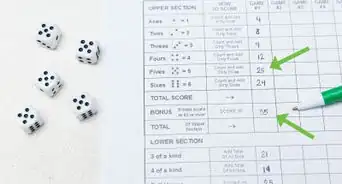
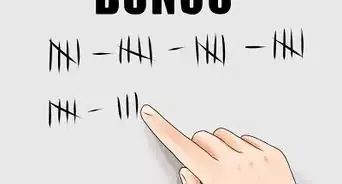

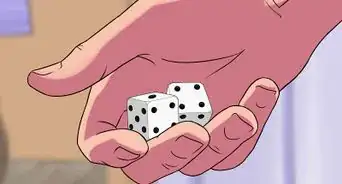
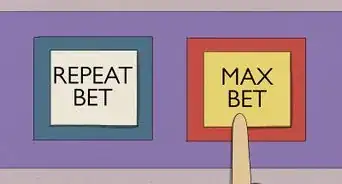

-Step-35.webp)
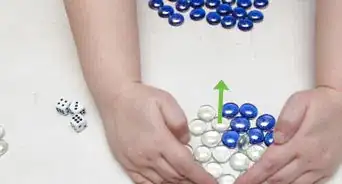
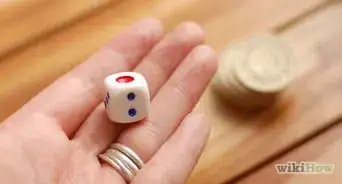
-Step-10.webp)









